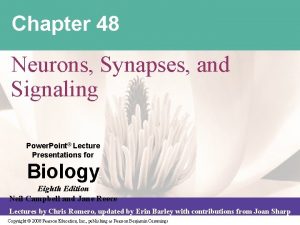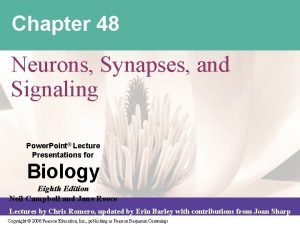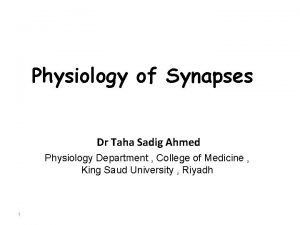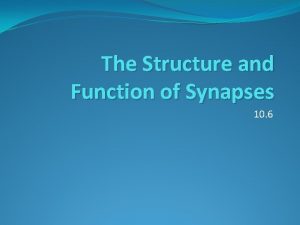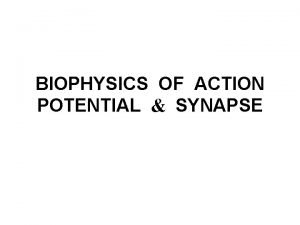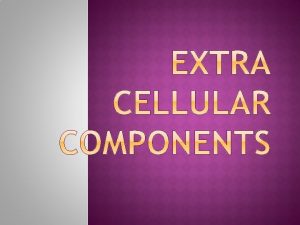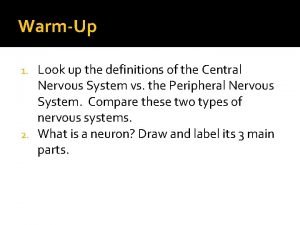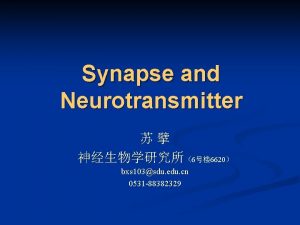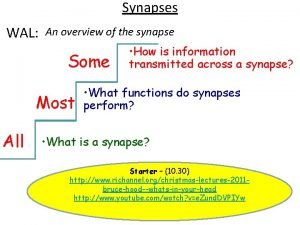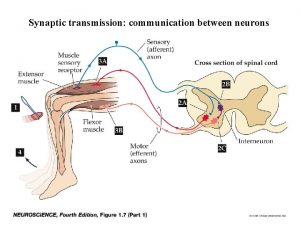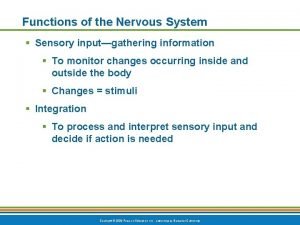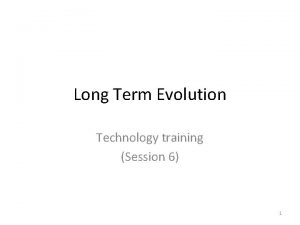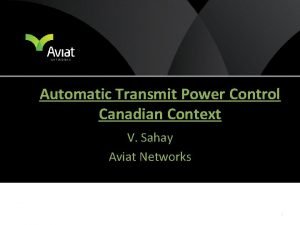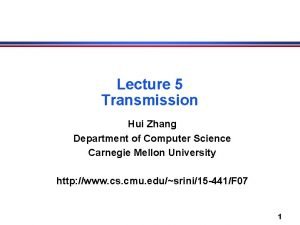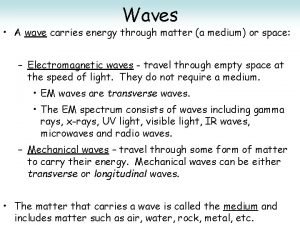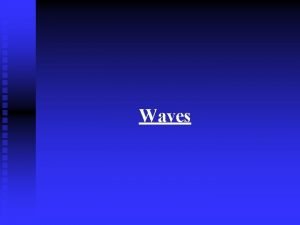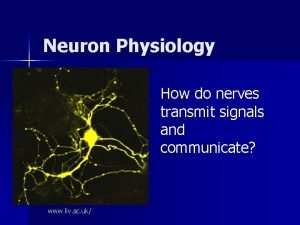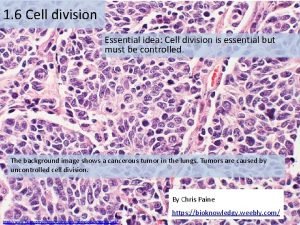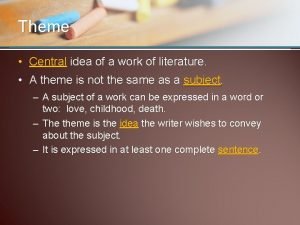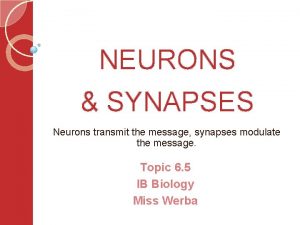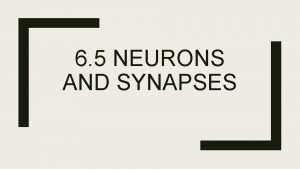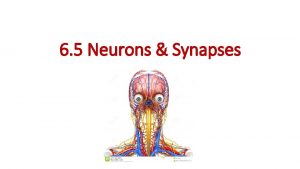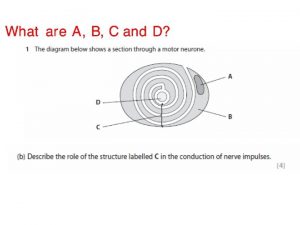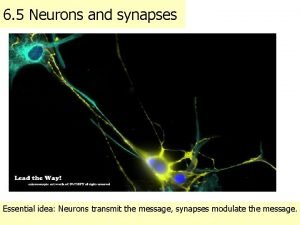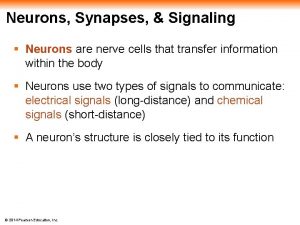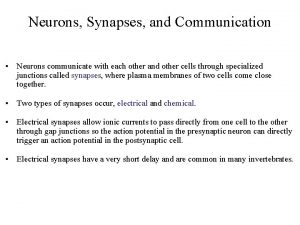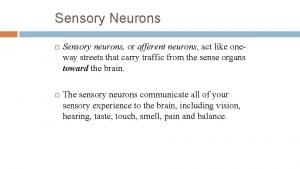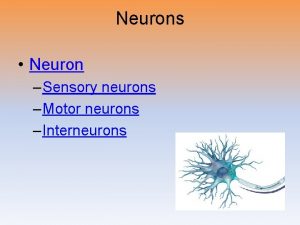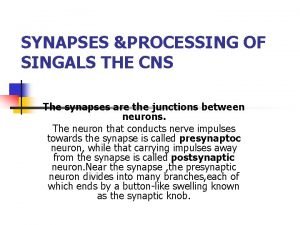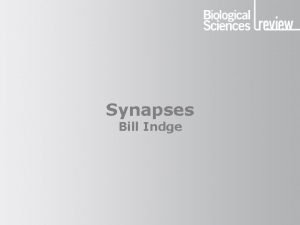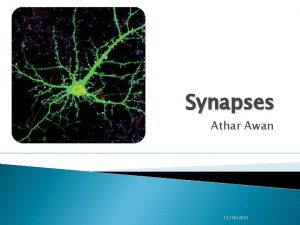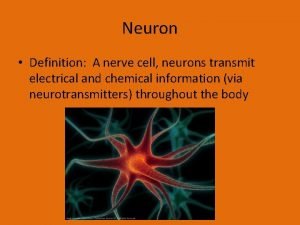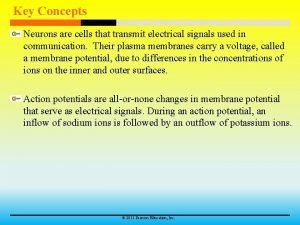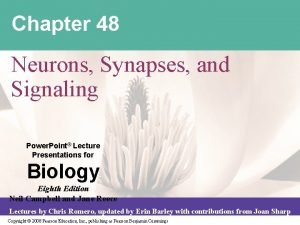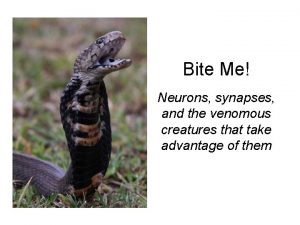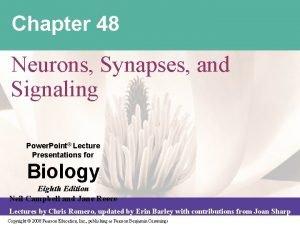Essential Idea Neurons transmit the message synapses modulate


























- Slides: 26

Essential Idea – Neurons transmit the message, synapses modulate the message. Neurons & Synapses


Neuron Structure Cell Membrane

Nerve Impulse Information passed rapidly in your body by electrical signals Result of changes in concentration of sodium (Na+) and potassium (K+) ions across the membrane This is how we measure the electrical activity of a neuron

How do impulses work? It’s all or nothing. Nerve impulse occurs only when a stimulus is strong enough to depolarize the neuron and pass the threshold.

The players… • Voltage gated channels – Sodium, Potassium • Active Transport – Sodium/Potass ium Pump – 3 Sodium out – 2 Potassium in

Nerve Impulse – Resting potential (-70 m. V) • The electrical potential across the plasma membrane of a cell that is not conducting an impulse • Maintained by active transport (Na+/K+ Pump) & diffusion Plasma membrane is 50 times more permeable to K+ ions than Na+

Nerve Impulse – Action Potential Action potential is the rapid change in membrane potential as an impulse travels along it. Two parts: Depolarization & Repolarization

Action Potential – Depolarization (+30 m. V) A change from negative to positive In response to a stimulus some voltage gated Na+ channels open and sodium enters the neuron by diffusion. If a threshold potential is reached, all the voltage gated Na+ channels open. The entry of Na+ causes the membrane potential to become positive

Action Potential - Repolarization A change back from positive to negative The depolarization of the membrane potential causes the voltage gated Na+ channels to close and the voltage gated K+ channels open. K+ diffuses out of the neuron rapidly and the membrane potential becomes negative again

Okay. . Now back to resting, right? Hyperpolarization • The K+ channels close slowly – The membrane is more negative than the resting potential. • Refractory period where the neuron cannot be further stimulated.

Pass it on. Action Potentials, once started, are passed on down the axon automatically. How does the nerve impulse travel down the neuron?

Refractory Potential (Ref. P) After an ion channel has opened, it needs a “rest period” before it can reopen – Can’t be reopened by the action potential down axon – Action potentials are one-way. • Only downstream channels open – Delay prevents the summation of action potentials (one impulse cannot catch up to another impulse)

Action Potential • High concentration of Na+ in the axon (Channels open) – diffuses to the next set of voltage gates causing depolarization Threshold (TH): • The ion channels are either open or closed; there is no halfway position. • Action potential = +40 m. V (the entire length of the axon)

Resting Potential Na+ diffuses If threshold is reached then the channel will open Na+ will flood in and a new action potential begins

Speed matters.

Myelination and saltatory conduction – from the Latin saltare, to hop • propagation along myelinated axons from one node of Ranvier to the next node • increases conduction velocity of action potentials. up to 200 m/s versus 2 m/s. • Reduces energy cost

It’s the end of the neuron. But the beginning of the message. • The Synapse – the space between the axon and the dendrite. – Pre-synaptic – Post-synaptic

In the synapse… • The electric signal is converted to a chemical message – called neurotransmitters. • Neurotransmitters (NTs) are made and stored in synaptic vesicles at the end of the axon. • The the post-synaptic neuron has chemical-gated ion channels called neuroreceptors. – specific binding sites for the neurotransmitters

Synapse Overview

Synaptic Transmission (7 steps) Nerve impulse reaches terminal end of presynaptic neuron Ca 2+ causes synaptic vesicles to move to the membrane and fuse Depolarization causes voltage gated calcium channels to open. Ca+ rushes in.

Synaptic Transmission (7 steps) NTs that were stored in the vesicle diffuse across the gap NTs bind with post-synaptic receptors (these are specific) Enzymes in the gap break down NTs. Pieces are taken up by pre-synaptic neuron via active transport. Sodium channels open (Na+ enters) depolarization and an action potential begins

• Neurotransmitter found in neurons and muscle cells • 2 parts: – acetyl (from respiration) – choline (from diet) Travels across the synapse to bind its receptor • Broken down by enzyme acetylcholinesterase in the synapse • Choline is absorbed by presynaptic neuron and re-used to make more acetylcholine. Acetylcholine

6. 5. A 2 Blocking of synaptic transmission at cholinergic synapses in insects by binding of neonicotinoid pesticides to acetylcholine receptors. Neonicotinoids: insecticide – synthetic chemical similar to nicotine – Safe for mammals – Non-specific insecticide • binds the acetylcholine receptor irreversibly • leads to paralysis and death in insects


 Chapter 48 neurons synapses and signaling
Chapter 48 neurons synapses and signaling Chapter 48 neurons synapses and signaling
Chapter 48 neurons synapses and signaling Taha kass-hout
Taha kass-hout Neuroglia
Neuroglia Unidirectionality synapses
Unidirectionality synapses Summation of postsynaptic potentials
Summation of postsynaptic potentials Plasmodesmata
Plasmodesmata Synapses telecom
Synapses telecom Bioflix activity: how synapses work -- synapse structure
Bioflix activity: how synapses work -- synapse structure 2 types of synapses
2 types of synapses Functions of a synapse
Functions of a synapse Chemical synapses
Chemical synapses Nervous cell
Nervous cell Characteristics of lipids
Characteristics of lipids Stores and transmits genetic (hereditary) information
Stores and transmits genetic (hereditary) information How does the approaching ceremony of twelves affect jonas?
How does the approaching ceremony of twelves affect jonas? Importanta dialogului in comunicare
Importanta dialogului in comunicare Transmit light
Transmit light Transmit diversity in lte
Transmit diversity in lte Automatic transmit power control
Automatic transmit power control Hui transmit data
Hui transmit data Carries energy through matter
Carries energy through matter Transmit waves
Transmit waves Neuron physiology
Neuron physiology Mechanical waves and electromagnetic waves venn diagram
Mechanical waves and electromagnetic waves venn diagram Essential idea
Essential idea The central idea of a work of literature
The central idea of a work of literature
